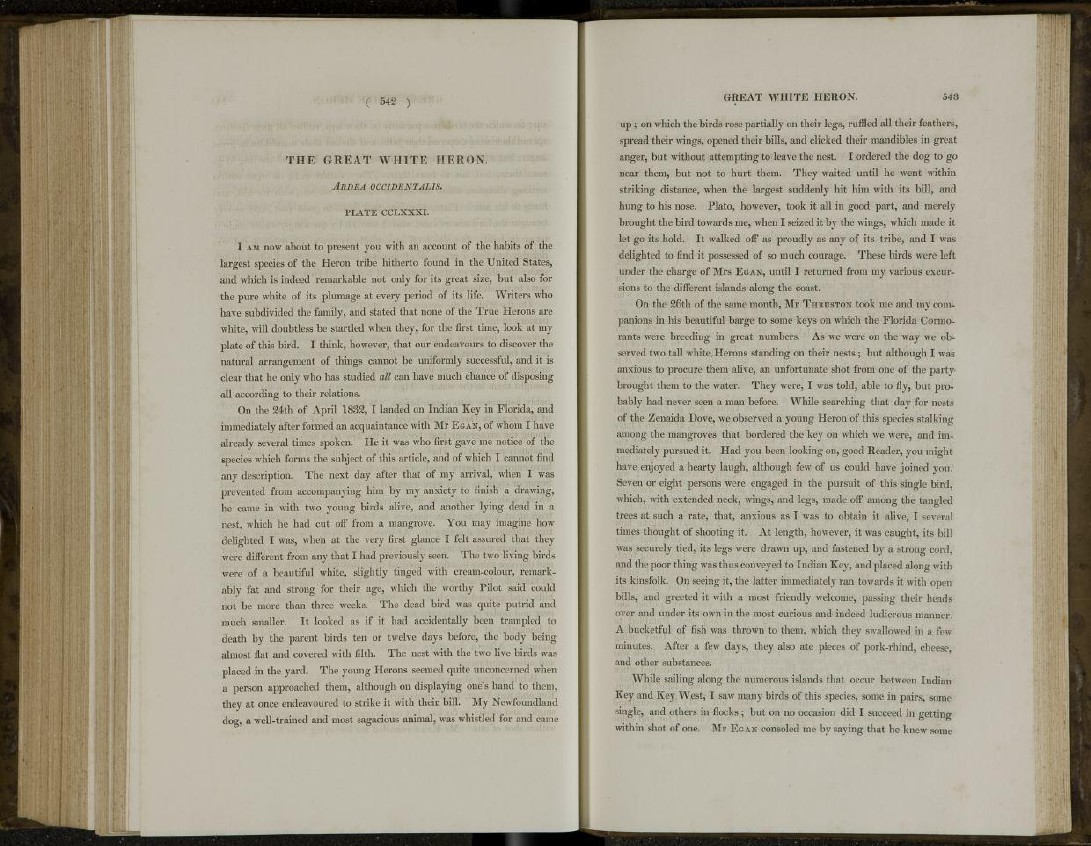
( 542 )
THE GREAT WHITE HERON.
ARDEA OCCIDENTALS.
PLATE CCLXXXI.
I AM now about to present you with an account of the habits of the
largest species of the Heron tribe hitherto found in the United States,
and which is indeed remarkable not only for its great size, but also for
the pure white of its plumage at every period of its life. Writers who
have subdivided the family, and stated that none of the True Herons are
white, will doubtless be startled when they, for the first time, look at my
plate of this bird. I think, however, that our endeavours to discover the
natural arrangement of things cannot be uniformly successful, and it is
clear that he only who has studied all can have much chance of disposing
all according to their relations.
On the 24th of April 1832, I landed on Indian Key in Florida, and
immediately after formed an acquaintance with Mr EGAN, of whom I have
already several times spoken. He it was who first gave me notice of the
species which forms the subject of this article, and of which I cannot find
any description. The next day after that of my arrival, when I was
prevented from accompanying him by my anxiety to finish a drawing,
he came in with two young birds alive, and another lying dead in a
nest, which he had cut off' from a mangrove. You may imagine how
delighted I was, when at the very first glance I felt assured that they
were different from any that I had previously seen. The two living birds
were of a beautiful white, slightly tinged with cream-colour, remarkably
fat and strong for their age, which the worthy Pilot said could
not be more than three weeks. The dead bird was quite putrid and
much smaller. It looked as if it had accidentally been trampled to
death by the parent birds ten or twelve days before, the body being
almost flat and covered with filth. The nest with the two live birds was
placed in the yard. The young Herons seemed quite unconcerned when
a person approached them, although on displaying one's hand to them,
they at once endeavoured to strike it with their bill. My Newfoundland
dog, a well-trained and most sagacious animal, was whistled for and came
GREAT WHITE HERON. 543
up ; on which the birds rose partially on their legs, ruffled all their feathers,
spread their wings, opened their bills, and clicked their mandibles in great
anger, but without attempting to leave the nest. I ordered the dog to go
near them, but not to hurt them. They waited until he went within
striking distance, when the largest suddenly hit him with its bill, and
hung to his nose. Plato, however, took it all in good part, and merely
brought the bird towards me, when I seized it by the wings, which made it
let go its hold. It walked off as proudly as any of its tribe, and I was
delighted to find it possessed of so much courage. These birds were left
under the charge of Mrs EGAN, until I returned from my various excursions
to the different islands along the coast.
On the 26th of the same month, Mr THRUSTON took me and my companions
in his beautiful barge to some keys on which the Florida Cormorants
were breeding in great numbers. As we were on the way we observed
two tall white,Herons standing on their nests; but although I was
anxious to procure them alive, an unfortunate shot from one of the partybrought
them to the water. They were, I was told, able to fly, but probably
had never seen a man before. While searching that day for nests
of the Zenaida Dove, we observed a young Heron of this species stalking
among the mangroves that bordered the key on which we were, and immediately
pursued it. Had you been looking on, good Reader, you might
have enjoyed a hearty laugh, although few of us could have joined you.
Seven or eight persons were engaged in the pursuit of this single bird,
which, with extended neck, wings, and legs, made off among the tangled
trees at such a rate, that, anxious as I was to obtain it alive, I several
times thought of shooting it. At length, however, it was caught, its bill
was securely tied, its legs were drawn up, and fastened by a strong cord,
and the poor thing was thus conveyed to Indian Key, and placed along with
its kinsfolk. On seeing it, the latter immediately ran towards it with open
bills, and greeted it with a most friendly welcome, passing their heads
over and under its own in the most curious and indeed ludicrous manner.
A bucketful of fish was thrown to them, which they swallowed in a few
minutes. After a few days, they also ate pieces of pork-rhind, cheese,
and other substances.
While sailing along the numerous islands that occur between Indian
Key and Key West, I saw many birds of this species, some in pairs, some
single, and others in flocks; but on no occasion did I succeed in getting
within shot of one. Mr EGAN consoled me by saying that he knew some